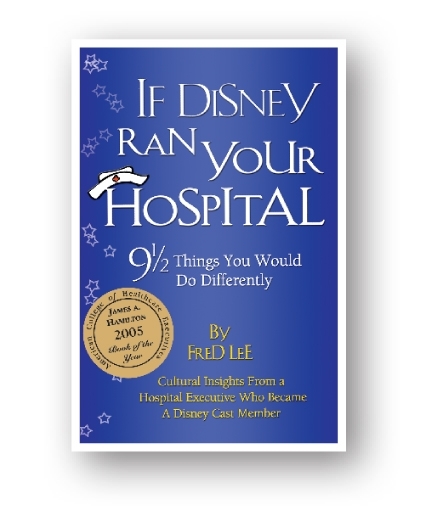If Disney Ran Your Hospital: 9 1/2 Things You Would Do Differently by Fred Lee

Author:Fred Lee
Language: eng
Format: mobi
Publisher: Second River Healthcare
Published: 2004-03-31T14:00:00+00:00
Performance
Star performers
Directing
Setting
Engaging
Scripting
Rapport
Relating
Roles
Talent
IT STARTS WITH A GOOD SCRIPT WHICH IS MORE THAN DIALOGUE.
Probably the most popular textbook for aspiring directors to study is Harold Clurman’s, On Directing. Notice how his definition of theater resonates with Pine and Gilmore’s “experience economy” and work as theater: “Theatre is a particular mode of expression through which a community realizes itself. The audience is the theatre’s wellspring, its leading actor. This is not a metaphor; it is a historical fact.”2
“Choose a good script,” he often admonishes his students, “cast good actors–and you’ll all be good directors.”3 The Disney organization would agree. Aspiring directors of hospital work processes would be well served by the same admonition.
A common practice in hospitals today is “scripting” which, to most managers, means simply writing out what employees are supposed to say in repetitive situations. Not so in theater. In theater the script is much more than just the words actors are supposed to say. A script maps out the entire experience, scene by scene. Everything that contributes to the desired outcome of the drama is in the script. It specifies the details and cues needed to carry out the intentions of every scene. It usually includes time frames, transitions between scenes, actions, set decoration, props, casting notes, actor’s appearance, staging details, and even subtext (what’s going on beneath the surface in the actor’s mind). Before it is produced, it is also shaped by the director’s extensive notes about the story, the spine (driving force behind actions and intentions), the atmosphere, the movement between characters, and a host of nuances not in the original script.
At Disney scripts are a collaborative effort, not the work of one playwright. Walt Disney is credited with the “storyboard” method of developing a plot and a script through collective brainstorming. Everyone can contribute to the shaping of the story because the storyboard is set up where all can see it and add their ideas on index cards. Since the cards are pinned to a corkboard-like surface, they can be freely moved, deleted, or expanded with details. Once the storyline is developed, complete with scenes and artistic cues, the staff begins the actual work of staging the experience for the audience within the constraints of the budget, medium, and tools they are using.
Download
This site does not store any files on its server. We only index and link to content provided by other sites. Please contact the content providers to delete copyright contents if any and email us, we'll remove relevant links or contents immediately.
| Administration & Medicine Economics | Allied Health Professions |
| Basic Sciences | Dentistry |
| History | Medical Informatics |
| Medicine | Nursing |
| Pharmacology | Psychology |
| Research | Veterinary Medicine |
Good by S. Walden(3489)
The Social Psychology of Inequality by Unknown(2941)
0041152001443424520 .pdf by Unknown(2784)
The Checklist Manifesto by Atul Gawande(2779)
The Meaning of the Library by unknow(2505)
Guns, Germs and Steel by Diamond Jared(2304)
Borders by unknow(2231)
23:27 by H. L. Roberts(2197)
And the Band Played On by Randy Shilts(2130)
Get What's Yours for Medicare: Maximize Your Coverage, Minimize Your Costs by Philip Moeller(2102)
Being Mortal: Medicine and What Matters in the End by Atul Gawande(2086)
A Leg to Stand On by Oliver Sacks(2006)
The Hot Zone by Richard Preston(1983)
The Valachi Papers by Peter Maas(1815)
The Laws of Medicine by Siddhartha Mukherjee(1757)
The Andromeda Strain by Michael Crichton(1697)
The Obesity Epidemic by Robyn Toomath(1648)
Pharmacy Practice and The Law by Richard Abood(1543)
Autism's False Prophets by Paul A. Offit(1496)
